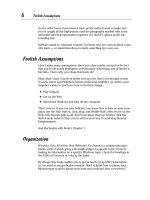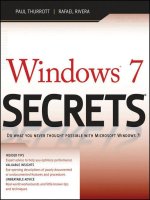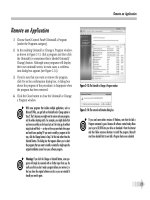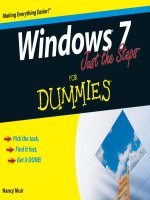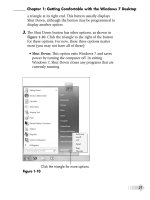Tài liệu Windows 7 Just the Steps for Dummles P1 doc
Bạn đang xem bản rút gọn của tài liệu. Xem và tải ngay bản đầy đủ của tài liệu tại đây (1.53 MB, 30 trang )
Making Everything Easier!
™
Nancy Muir
Pick the task,
Find it fast,
Get it DONE!
Windows
®
7
Muir
Windows
®
7
Easy steps for
getting up to speed
with Windows 7 — fast
Simple steps...
Create and Play a Slide Show
1. Choose Start➪Pictures. Double-click the Pictures
Library folder to display all pictures within it.
2. Click the check box next to an image to select it.
Repeat this to select all the photos you want to
appear in the slide show (see Figure 22-10).
3. Click the Slide Show button. The first image
appears in a separate full-screen display (click
Alt+Tab to go to this display). The slides move
forward automatically, cycling among the photos
repeatedly (see Figure 22-11).
4. Press Esc to stop the slide show.
If you want a more sophisticated slide show feature, check
out Windows Media Center. Here you can create and save
any number of custom slide shows, reorganize slides, and
edit slide shows to add or delete photos. You might also
consider a commercial slide show program, such as
PowerPoint, if you want to create more complex slide shows.
...for great results
Operating Systems/Windows
Concise, step-by-step instructions
“Get in, get out” information
Easy-to-recognize tasks and topics
Quick solutions to get it done
A dash of humor and fun
$16.99 US
$19.99 CN
£13.99 UK
ISBN: 978-0-470-49981-8
spine=.46"
Open the book
and find:
• What to do with the Gadget
Gallery
• Built-in apps and how to use
them
• New features in Internet
Explorer 8
• Fast ways to fi nd fi les and
folders
• How to repair an Internet
connection
• An e-mail setup guide
• Security advice
• Troubleshooting tips
Go to Dummies.com
®
for videos, step-by-step examples,
how-to articles, or to shop!
Access point: A device used by a wire-
less network to send and receive data
between network computers or the
Internet.
Active: The object, icon, or window that’s
selected. Items that aren’t selected are
referred to as inactive.
Attribute: Characteristics of a file,
including Read-Only, Hidden,
Compressed, or Encrypted.
Browser: A software program, such as
Internet Explorer, that you use to navi-
gate the Internet.
Desktop: The main view of Windows 7,
containing shortcuts to various programs
and files on your computer as well as on
the Windows 7 taskbar and Start menu.
Device driver: The software that enables
peripheral devices, such as a printer or a
modem, to interact with the operating
system.
Download: To copy a file from a Web site
or other computer to another computer
or storage device via a modem, wireless
connection, or network. See also Upload.
Drive: A storage area on a computer CPU
or on external media (such as a CD-ROM
or DVD) designated with a drive letter
(such as C).
Firewall: A software program that
protects your computer by keeping
unauthorized people out of your system.
Cool Windows 7 Lingo
Gadget: A small useful program, such
as a calculator or stock ticker, you can
access through the Gadget Gallery.
Modem: A hardware device that facili-
tates the transfer of computer data over
a telephone line (taken from the terms
modulator/demodulator).
Network: A group of computers and
other devices that are connected via
a wired or wireless connection so that
they can interact with one another and
exchange or share data.
Peripheral: A hardware device attached
to a computer, such as a printer, modem,
digital camera, or scanner. Peripherals
are controlled by the computer to which
they’re attached.
Pin: A function of Windows 7 that allows
you to place items on the taskbar.
Plug and Play: A set of specifications
that enables peripherals to be instantly
recognized and configured when
connected to a computer.
Restore point: A moment in time
when all settings and configurations on
your computer are saved. You can use
a restore point to put your computer
settings back to the way they were
at that point in time in order to fix a
problem introduced by a change in
settings.
Screen resolution: The amount of data
displayed on your monitor. Resolution
is measured in pixels. Common settings
include 800 x 600 pixels and 1024 x 768
pixels. You set the screen resolution in
the Windows Control Panel.
Shortcut: An icon, for example on the
Windows desktop or a menu, that you
can double-click to open a program or
folder.
Sidebar:
A panel that you can display
on the Windows desktop that contains
useful small programs, or gadgets.
System restore:
The Windows 7
feature used to keep track of changes
on your computer by creating restore
points either automatically or manually.
See also Restore point.
Upload:
To copy a file from a computer
or storage media to a location on the
Internet via a modem, wireless connec-
tion, or network.
USB (Universal Serial Bus)
port: A
type of port on your computer used to
connect Plug and Play devices, such as
printers and digital cameras.
Wireless:
Use of infrared light or wire-
less technology, such as Bluetooth, to
transmit data between computers and
other devices without the need for
wires.
Wizard:
A Windows tool for guiding
users through a process by presenting
various options for them to choose from
or requesting specific input.
What Do You Want to Do? Try This Task Find It Here
Work in Windows 7 Work with the Start Menu 7
Search for a File 29
Create a Formatted Document in WordPad 38
Master the Internet Set Up a New ISP Internet Connection 58
Navigate the Web 66
Create and Send E-Mail 85
Set Up Hardware or a Network Install a Printer 108
Upgrade a Graphics Card 113
Configure a Wireless Network 121
Customize Windows Change the Desktop Background 131
Choose a Desktop Theme 132
Change Mouse Behavior 144
Maintain Your System Run Windows Update 163
Defragment a Hard Drive 167
Delete Temporary Internet Files 169
Fix Common Problems Use the Hardware Troubleshooter 175
Update a Driver 176
Create a System Restore Point 182
Entertain Yourself Play Solitaire 196
Play Music 209
Create and Play a Slideshow 217
Hundreds of tasks including:
spine=.46"
by Nancy Muir
Windows
®
7
Just the Steps
™
FOR
DUMmIES
‰
01_499818-ffirs.indd i01_499818-ffirs.indd i 8/11/09 8:57 AM8/11/09 8:57 AM
Windows
®
7 Just the Steps™ For Dummies
®
Published by
Wiley Publishing, Inc.
111 River Street
Hoboken, NJ 07030-5774
www.wiley.com
Copyright © 2009 by Wiley Publishing, Inc., Indianapolis, Indiana
Published by Wiley Publishing, Inc., Indianapolis, Indiana
Published simultaneously in Canada
No part of this publication may be reproduced, stored in a retrieval system or transmitted in any form or by any means, electronic, mechanical,
photocopying, recording, scanning or otherwise, except as permitted under Sections 107 or 108 of the 1976 United States Copyright Act, without
either the prior written permission of the Publisher, or authorization through payment of the appropriate per-copy fee to the Copyright Clearance
Center, 222 Rosewood Drive, Danvers, MA 01923, (978) 750-8400, fax (978) 646-8600. Requests to the Publisher for permission should be
addressed to the Permissions Department, John Wiley & Sons, Inc., 111 River Street, Hoboken, NJ 07030, (201) 748-6011, fax (201) 748-6008, or
online at />Trademarks: Wiley, the Wiley Publishing logo, For Dummies, the Dummies Man logo, A Reference for the Rest of Us!, The Dummies Way,
Dummies Daily, The Fun and Easy Way, Dummies.com, Just the Steps, Making Everything Easier, and related trade dress are trademarks or regis-
tered trademarks of John Wiley & Sons, Inc. and/or its affiliates in the United States and other countries, and may not be used without written per-
mission. Windows is a registered trademark of Microsoft Corporation in the United States and/or other countries. All other trademarks are the
property of their respective owners. Wiley Publishing, Inc., is not associated with any product or vendor mentioned in this book.
LIMIT OF LIABILITY/DISCLAIMER OF WARRANTY: THE PUBLISHER AND THE AUTHOR MAKE NO REPRESENTATIONS OR WARRANTIES WITH
RESPECT TO THE ACCURACY OR COMPLETENESS OF THE CONTENTS OF THIS WORK AND SPECIFICALLY DISCLAIM ALL WARRANTIES,
INCLUDING WITHOUT LIMITATION WARRANTIES OF FITNESS FOR A PARTICULAR PURPOSE. NO WARRANTY MAY BE CREATED OR EXTENDED
BY SALES OR PROMOTIONAL MATERIALS. THE ADVICE AND STRATEGIES CONTAINED HEREIN MAY NOT BE SUITABLE FOR EVERY SITUATION.
THIS WORK IS SOLD WITH THE UNDERSTANDING THAT THE PUBLISHER IS NOT ENGAGED IN RENDERING LEGAL, ACCOUNTING, OR
OTHER PROFESSIONAL SERVICES. IF PROFESSIONAL ASSISTANCE IS REQUIRED, THE SERVICES OF A COMPETENT PROFESSIONAL PERSON
SHOULD BE SOUGHT. NEITHER THE PUBLISHER NOR THE AUTHOR SHALL BE LIABLE FOR DAMAGES ARISING HEREFROM. THE FACT THAT
AN ORGANIZATION OR WEBSITE IS REFERRED TO IN THIS WORK AS A CITATION AND/OR A POTENTIAL SOURCE OF FURTHER INFORMATION
DOES NOT MEAN THAT THE AUTHOR OR THE PUBLISHER ENDORSES THE INFORMATION THE ORGANIZATION OR WEBSITE MAY PROVIDE
OR RECOMMENDATIONS IT MAY MAKE. FURTHER, READERS SHOULD BE AWARE THAT INTERNET WEBSITES LISTED IN THIS WORK MAY
HAVE CHANGED OR DISAPPEARED BETWEEN WHEN THIS WORK WAS WRITTEN AND WHEN IT IS READ.
For general information on our other products and services, please contact our Customer Care Department within the U.S. at 877-762-2974,
outside the U.S. at 317-572-3993, or fax 317-572-4002.
For technical support, please visit www.wiley.com/techsupport.
Wiley also publishes its books in a variety of electronic formats. Some content that appears in print may not be available in electronic books.
Library of Congress Control Number: 2009932705
ISBN: 978-0-470-49981-8
Manufactured in the United States of America
10 9 8 7 6 5 4 3 2 1
01_499818-ffirs.indd ii01_499818-ffirs.indd ii 8/11/09 8:57 AM8/11/09 8:57 AM
About the Author
Nancy Muir is the author of over 50 books on tech-
nology and business topics. She has worked as a
manager in both the publishing and software indus-
tries. Nancy holds a certificate in distance learning
design and is the VP of Content and Curriculum for
LOOKBOTHWAYS Foundation, an Internet safety
company dedicated to developing free safety curricu-
lums for children in grades K–12.
Dedication
To my fabulous husband, Earl Boysen, and my family
and friends who make my tough deadlines and other
writing stresses endurable.
Author’s Acknowledgments
Thanks so much to all the folks at Wiley Publishing
who make working with them such a pleasure, includ-
ing acquisitions editor Kyle Looper, project editor Kim
Darosett, copy editor Jen Riggs, and technical editor
Lee Musick.
01_499818-ffirs.indd iii01_499818-ffirs.indd iii 8/11/09 8:57 AM8/11/09 8:57 AM
Acquisitions and Editorial
Project Editor: Kim Darosett
Acquisitions Editor: Kyle Looper
Copy Editor: Jen Riggs
Technical Editor: Lee Musick
Editorial Manager: Leah Cameron
Sr. Editorial Assistant: Cherie Case
Cartoons: Rich Tennant (www.the5thwave.com)
Composition Services
Project Coordinator: Katherine Crocker
Layout and Graphics: Claudia Bell, Ana Carrillo,
Melanee Habig, Joyce Haughey, Andrea Hornberger,
Melissa K. Jester, Christin Swinford
Proofreaders: Dwight Ramsey, Mildred Rosenzweig
Indexer: Johnna VanHoose Dinse
Publisher’s Acknowledgments
We’re proud of this book; please send us your comments through our online registration form located at .
For other comments, please contact our Customer Care Department within the U.S. at 877-762-2974, outside the U.S. at 317-572-3993, or
fax 317-572-4002.
Some of the people who helped bring this book to market include the following:
Publishing and Editorial for Technology Dummies
Richard Swadley, Vice President and Executive Group Publisher
Andy Cummings, Vice President and Publisher
Mary Bednarek, Executive Acquisitions Director
Mary C. Corder, Editorial Director
Publishing for Consumer Dummies
Diane Graves Steele, Vice President and Publisher
Composition Services
Debbie Stailey, Director of Composition Services
01_499818-ffirs.indd iv01_499818-ffirs.indd iv 8/11/09 8:57 AM8/11/09 8:57 AM
Introduction ............................................1
Part I: Working in Windows 7 ..................3
Chapter 1: Exploring the Windows 7 Desktop .............................5
Chapter 2: Controlling Applications with Windows 7 ..............15
Chapter 3: Working with Files and Folders ................................25
Chapter 4: Using Built-In Windows Applications ......................37
Chapter 5: Using the Windows Gadget Gallery and Gadgets ....45
Part II: Getting on the Internet ..............55
Chapter 6: Accessing the Internet ................................................57
Chapter 7: Browsing the Web with Internet Explorer ................65
Chapter 8: Exchanging E-Mail with Windows Live Mail............83
Chapter 9: Working Remotely .....................................................97
Part III: Setting Up Hardware
and Networks .....................................105
Chapter 10: Setting Up New Hardware .....................................107
Chapter 11: Setting Up a Network ............................................117
Part IV: Customizing Windows ............127
Chapter 12: Setting Up Your Display ........................................129
Chapter 13: Customize Windows Ease of Access .....................137
Part V: Using Security and
Maintenance Features .........................147
Chapter 14: Setting Passwords and File Access .........................149
Chapter 15: Protecting Windows ...............................................157
Chapter 16: Maintaining Windows ...........................................165
Part VI: Fixing Common Problems .........171
Chapter 17: Troubleshooting Hardware Problems ..................173
Chapter 18: Troubleshooting Software Problems ....................179
Chapter 19: Getting Help ...........................................................185
Part VII: Fun and Games .....................193
Chapter 20: Playing Games in Windows 7 ...............................195
Chapter 21: Playing Music in Windows 7 .................................203
Chapter 22: Working with Photos .............................................211
Index ..................................................219
Contents at a Glance
02_499818-ftoc.indd v02_499818-ftoc.indd v 8/11/09 8:51 AM8/11/09 8:51 AM
02_499818-ftoc.indd vi02_499818-ftoc.indd vi 8/11/09 8:51 AM8/11/09 8:51 AM
#
➟
Chapter
I
’m guessing you have a healthy dislike of computer books. You don’t
want to wade through a long tome on Windows 7. Rather, you just want
to get in, find out how to do something, and get out. You’re not alone. I was
itching to write a book where I could get right to the details of how to do
things — and move on. None of that telling you what I’m going to tell you,
saying my piece, and then reviewing for you what I just said. That’s why I
was delighted to tackle a Just the Steps For Dummies book on Windows 7.
About This Book
Windows 7 is a very robust piece of software, with about as much function-
ality as Einstein on a good day. If you own a Windows 7 computer (and I
assume you do, or you should rush back to the bookstore for a refund,
pronto!), you’re likely to spend a lot of time every day in the Windows 7
environment. Knowing how to harness the power of this operating system is
what this book is all about. As the title suggests, I give you just the steps you
need to do many of the most common Windows 7 tasks. This book is all
about getting productive right away.
Why You Need This Book
You can’t wait weeks to master Windows 7. It’s where all your software lives
as well as how you get to your e-mail and documents. You have to figure
out Windows 7 quickly. You might need to poke around Windows and do
work while learning. When you hit a bump in the road, you need a quick
answer to get you moving again. This book is full of quick, clear steps that
keep your learning in high gear.
Conventions used
in this book
➟
When you have to type something in a text
box, I put it in bold type.
➟
For menu commands, I use the
➪
symbol to
separate menu items. For example, choose
Tools
➪
Internet Options. The
➪
symbol is just
my way of saying “Choose Internet Options
from the Tools menu.”
➟
Points of interest in some figures are circled.
The text tells you what to look for, and the
circle makes it easy to find.
This icon points out insights or helpful
suggestions related to tasks in the
step list.
➟
Introduction
03_499818-intro.indd 103_499818-intro.indd 1 8/11/09 8:57 AM8/11/09 8:57 AM
➟
2
Windows 7 Just the Steps For Dummies
modify how features such as your mouse and keyboard
work to help you if you have dexterity challenges, and set
up the Windows Speech Recognition feature.
Part V: Using Security and Maintenance Features
Windows 7 provides lots of ways to keep your informa-
tion safe, from passwords to protect your files to tools to
prevent viruses and spyware from attacking your system.
Several features also help keep your system up to date
and trouble-free.
Part VI: Fixing Common Problems
Yes, I admit it, even Windows can have problems.
Luckily, it also has tools to get you out of trouble. In this
part, I explain how to deal with hardware and software
problems as well as how to get help when you need it.
Part VII: Fun and Games
Finally, you’ve earned some fun. Go to these chapters to
discover a world of games, music, photos, and video just
waiting for you in Windows 7.
Get Ready To . . .
Whether you need to open a piece of software and get
working, check your e-mail, or get online, just browse
this book, pick a task, and jump in. Windows 7 can be
your best friend if you know how to use it, and the tasks
covered in this book will make you a Windows 7 master
in no time.
How This Book Is Organized
This book is conveniently divided into several handy parts.
Part I: Working in Windows 7
Here’s where you get the basics of opening and closing soft-
ware applications, working with files and folders to manage
the documents you create, and using built-in Windows appli-
cations like the Calculator and WordPad. You also discover
how to use the cool tools offered in Windows Gadget Gallery.
Part II: Getting on the Internet
The whole world is online, and you can’t be left behind.
Here’s where I show you how to connect, how to browse
using the newest version of Internet Explorer, ways for using
the Internet to stay in touch when you’re on the road, and
how to do e-mail using Windows Live Mail.
Part III: Setting Up Hardware and Networks
In addition to software, Windows helps you work with hard-
ware and connections between computers. You might have
to make a little effort to set up new hardware or a home net-
work. This part is where I show you how to do that, as well
as how to make settings so displays and devices are easy to
use and accessible if you have any vision, hearing, or other
physical challenges.
Part IV: Customizing Windows
You can change a great deal about the appearance of the
Windows desktop, including the background, colors, and a
transparent effect called Windows Glass. In addition, you can
03_499818-intro.indd 203_499818-intro.indd 2 8/11/09 8:57 AM8/11/09 8:57 AM
Part I
Working in Windows 7
04_499818-pp01.indd 304_499818-pp01.indd 3 8/11/09 8:58 AM8/11/09 8:58 AM
Chapter 1: Exploring the Windows 7 Desktop . . . . . . .5
Log On and Off Windows 7 ..................................... 6
Work with the Start Menu ........................................ 7
Work with Frequently Used Programs ..................... 8
Set the Date and Time .............................................. 9
Arrange Icons on the Desktop ................................ 10
Create a Desktop Shortcut ...................................... 11
Empty the Recycle Bin ............................................ 12
Shut Down Your Computer ................................... 13
Chapter 2: Controlling Applications with
Windows 7 . . . . . . . . . . . . . . . . . . . . . . . . . . . . . . .15
Launch an Application ............................................ 16
Resize Application Windows .................................. 17
Switch between Running Applications ..................18
Move Information between Applications ..............19
Start an Application Automatically ........................20
Close an Application ............................................... 21
Set Program Defaults ..............................................22
Remove an Application ..........................................23
Chapter 3: Working with Files and Folders. . . . . . . . .25
Access Recently Used Items from
the Start Menu .......................................................26
Locate Files and Folders in Your Computer .......... 27
Locate Files and Folders in Windows Explorer .....28
Search for a File .......................................................29
Move a File or Folder ..............................................30
Rename a File or Folder .......................................... 31
Create a Shortcut to a File or Folder ......................31
Print a File................................................................32
Delete a File or Folder .............................................33
Create a Compressed File or Folder ....................... 34
Add a File to Your Favorites List ............................35
Chapter 4: Using Built-In Windows Applications. . . . .37
Create a Formatted Document in WordPad .......... 38
Edit a Picture in Paint ............................................. 39
View a Digital Image in the Windows
Photo Viewer ......................................................... 40
Clip with the Windows Snipping Tool .................. 42
Add Sticky Notes .....................................................43
Track Numbers with Windows Calculator ............ 44
Chapter 5: Using the Windows Gadget Gallery
and Gadgets. . . . . . . . . . . . . . . . . . . . . . . . . . . . . . .45
Open the Gadget Gallery and
Add Gadgets to the Desktop ................................ 46
Check the Time .......................................................47
Display a Continuous Slide Show ......................... 48
Use the Windows Calendar ....................................49
Play with Puzzles .....................................................50
Convert Currency ....................................................51
Use the Feed Headlines Gadget ..............................52
Get the Latest Stock Quotes ....................................53
Monitor Your CPU .................................................. 54
04_499818-pp01.indd 404_499818-pp01.indd 4 8/11/09 8:58 AM8/11/09 8:58 AM


